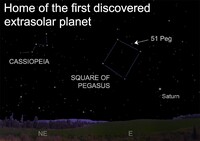Week of October 5-11, 2025
I recall as a child lying on the grass at night, gazing up at the stars, and wondering if any of those distant suns had planets orbiting nearby.
I was not the first to do so, of course. The question had been pondered by others for millennia. In a letter to Herodotus, the ancient Greek philosopher Epicurus (341-270 B.C.) wrote: "There are infinite worlds both like and unlike this world of ours. ... We must believe that in all worlds there are living creatures and plants and other living things we see in this world."
Even before these now-famous words, Thales of Miletus in the sixth century B.C. taught that the stars and the Earth are made of the same materials. His student Anaximander extrapolated further that if the universe is infinite and the makeup of all its parts is identical, then there must be an infinite number of worlds out there.
But pondering such weighty questions and finding other worlds among the stars are two completely different matters. Just imagine trying to find a small planet-sized body near a glaring sun many trillions of miles away. That's what astronomers have always been up against, and such a planet had never been reported.
Not until 1963, that is. In that year, Swarthmore College astronomer Peter Van de Kamp described a small red star (Barnard's Star) that wobbled as it drifted through space, a telltale sign that something must be orbiting nearby and tugging on it gravitationally.
The excitement didn't last long, however. Other astronomers eventually found just enough errors in the measurement process to determine that this planet was most likely not real.
But when a similar announcement was made 30 years ago this week by Swiss astronomers Michel Mayor and Didier Queloz, it rocked the astronomical community and earned them the 2019 Nobel Prize in Physics.
Using a much more advanced technique than Van de Kamp, they found that the sunlike star 51 Pegasi — affectionately known to astronomers as 51 Peg — some 50.9 lightyears away, appeared to be wobbling as if a planet was pulling on it. This new world was originally designated 51 Pegasi but is now called Dimidium, the Latin word for "half," because it is believed to contain nearly half the mass of Jupiter.
Today, astronomers have at least a dozen techniques to seek and detect planets orbiting other stars, and have turned up thousands. But 51 Peg will always be special since it was our first. Not only that, but it's a star that backyard stargazers can find easily.
This week, go outdoors after dark and look midway up in the eastern sky. There you should spot the four stars outlining the Great Square of Pegasus. With the accompanying map in hand, you'll be able to identify it easily.
If your sky is dark and relatively free from light pollution or moonlight, try to spot 51 Peg (perhaps with binoculars). It's located almost midway between the two westernmost stars of the square, and slightly west of the line connecting them.
To learn more about the discovery of these distant worlds, check out the website science.nasa.gov and scroll down to the exoplanet section.
Visit Dennis Mammana at dennismammana.com. To read features by other Creators Syndicate writers and cartoonists, visit the Creators Syndicate website at creators.com.
Thirty years ago, astronomers Michel Mayor and Didier Queloz discovered the sunlike star 51 Pegasi.







View Comments